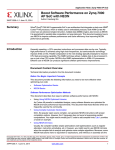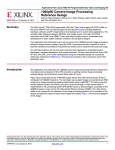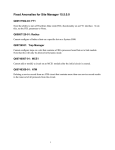Download Gimme2 user guide v5
Transcript
GIMME2 User Guide Document revision: 5 Date [dd.mm.yyyy]: 05.06.2013 af inventions Use Us e r G uide G imme2 imme2 1 Document Document revisions Revision 1 2 Date [DD.MM.YY] 20.12.12 07.02.13 3 4 5 14.02.13 18.02.13 05.06.13 Changes Initial version Added mechanical drawing and board revision section. Added component information Added BOOT_MODE Jumper description Extended description of boot mode jumper options Added reference design QSPI programming sequence Page 2 of 12 af inventions Use Us e r G uide G imme2 imme2 2 Functionality Functionality 2.1 Overview The GIMME2 system is based on the Xilinx Zynq-7000 Extensible Processing Platform (EPP) and hosts a variety of devices and interfaces, see block diagram in Figure 1. All peripherals are connected to the Zynq device, either to the FPGA fabric (PL) or directly to the Processing System (PS). All connectors are available on the PCB top side and the CMOS sensors are mounted on the PCB bottom side. USB0 USB1 USB2 2x USB-Serial GE0 (RJ45) USB PHY ZynQ 7020 PS FE0 (RJ45) FE PHY 2x GE PHY CMOS camera OV10810 CMOS camera OV10810 GE1 (RJ45) APU 2x ARM Cortex-A9 CPU Power supplies PL FPGA fabric MEM1 2Gb DDR3 MEM0 4Gb DDR3 microSD QSPI flash Figure 1 GIMME2 system overview Page 3 of 12 af inventions Use Us e r G uide G imme2 imme2 3 Components omponents In Figure 2 shows the Gimme2 PCB top side. Figure 2 Gimme2 PCB top side 3.1 Connector positions Figure 3 GIMME2 connectors and mounting holes Page 4 of 12 af inventions Use Us e r G uide G imme2 imme2 3.2 Connector overview Please note the pin 1 identifiers in Figure 1. Designator Function Connector type P1 P2 P4 P5 P6 P7 RJ45 RJ45 USB Micro-AB USB Micro-AB USB Micro-AB Shrouded pin header, 2x10, 2.54mm pitch Molex 502570-0893 Shrouded pin header, 2x10, 2.54mm pitch Molex 87832-1420 P13 Gigabit Ethernet 0 (GE0) Fast Ethernet 0 (FE0) USB on-the-go / host /device (USB2) USB UART device (USB0 - UART0) USB UART device (USB1 – UART1) ARM PJTAG debug connector (ARM_PJTAG), access through Zynq PL µSD connector ARM JTAG debug connector (ARM_JTAG) Xilinx JTAG connector, same as ARM_JTAG Power supply connector (+24V) P14 P23 P26 P27 P28 P29 P30 FPGA GPIO 1.5V Gigabit Ethernet 1 (GE1) Boot mode jumper (BOOT_MODE[4]) Boot mode jumper (BOOT_MODE[3]) Boot mode jumper (BOOT_MODE[2]) Boot mode jumper (BOOT_MODE[1]) FPGA GPIO 2.5V P8 P10 P11 Phoenix Contact: MC 1,5/ 2-GF-3,81 – 1827868 Pin header, 2x8, 2.54mm pitch RJ45 Pin header, 1x3, 2.54mm pitch Pin header, 1x3, 2.54mm pitch Pin header, 1x3, 2.54mm pitch Pin header, 1x3, 2.54mm pitch Pin header, 2x8, 2.54mm pitch 3.3 Connector pinouts In this section the pinouts of the GIMME2 board connectors are listed. All Ethernet and USB connectors have standard pinouts. 3.3.1 P7 – ARM PJTAG debug connector The P7 ARM debug connector pinout is listed in the table below. Pin 1 3 5 7 9 11 13 15 17 19 Function VREF (3.3V from board) nTRST (unused) TDI TMS TCK RTCK (unused) TDO nSRST (ARM soft reset) DBGRQ (unused) DBBACK (unused) Pin 2 4 6 8 10 12 14 16 18 20 Function Not connected GND GND GND GND GND GND GND GND GND Note that the PJTAG chain is routed through Zynq PL FPGA fabric and a suitable bitstream must be loaded before operating this JTAG chain. The Zynq pinout for these signals are listed in the table below: Net ARM_PJTAG_TCK ARM_PJTAG_TMS Zynq Pad Y9 U9 Page 5 of 12 af inventions ARM_PJTAG_TDI ARM_PJTAG_TDO Use Us e r G uide G imme2 imme2 V9 V7 3.3.2 P10 – ARM JTAG debug connector The P10 ARM debug connector controls the dedicated JTAG chain pins of the Zynq, granting access to both ARM cores and PL logic. This connector is connected parallel to the Xilinx JTAG programmer connector P11 and only one of these connectors should be used at a time. The P10 pinout is listed in the table below: Pin 1 3 5 7 9 11 13 15 17 19 Function VREF (3.3V from board) nTRST (unused) TDI TMS TCK RTCK (unused) TDO nSRST (ARM soft reset) DBGRQ (unused) DBBACK (unused) Pin 2 4 6 8 10 12 14 16 18 20 Function Function Not connected GND GND GND GND GND GND GND GND GND 3.3.3 P11 – Xilinx JTAG programmer connector The P10 ARM debug connector controls the dedicated JTAG chain pins of the Zynq, granting access to both ARM cores and PL logic. This connector is connected parallel to the ARM JTAG debug connector P10 and only one of these connectors should be used at a time. The P11 Xilinx programmer connector has the following standard pinout: Pin 1 3 5 7 9 11 13 Function GND GND GND GND GND GND GND Pin 2 4 6 8 10 12 14 Function VREF (3.3V from board) TMS TCK TDO TDI Not connected nSRST (ARM soft reset) 3.3.4 P13 power po wer supply connector The 12VDC to 24VDC supply voltage should be applied to the P13 connector with the pinout: Pin 1 2 Function VIN+ GND 3.3.5 P14 FPGA GPIO 1 .5V connector The 1.5V GPIO signals are available through the P14 connector. All GPIOs have a series resistor of approx.. 50 Ohms and ESD protection diodes to prevent damage to the input and output buffers of the Zynq device, however care should be taken not to expose these pins to overvoltage conditions. The pinout of the P14 connector is listed below: Page 6 of 12 af inventions Pin 1 3 5 7 9 11 13 15 Use Us e r G uide G imme2 imme2 Function GPIO_6 GPIO_7 GPIO_8 GPIO_9 GPIO_10 GPIO_11 GPIO_12 GPIO_13 Pin 2 4 6 8 10 12 14 16 Function GND GND GND GND GND GND GND GND 3.3.6 P26 – P29 boot mode jumpers The boot mode jumpers select the Zynq PS boot mode. A jumper should be placed between the pins 1+2 to assert (logic ‘1’) the corresponding boot mode bit. To deassert (logic ‘0’), a jumper should be placed between the pins 2+3. The mapping of connectors to boot mode bits is listed in the table below: Connector P26 P27 P28 P29 Boot Mode Bit BOOT_MOD[4] BOOT_MOD[3] BOOT_MOD[2] BOOT_MOD[1] Configuration ‘0’ => PLL used, ‘1’ => PLL bypassed ‘0’ => cascaded JTAG, ‘1’ => independent JTAG BOOT_MODE[2..1]: “00” => Boot from JTAG “10” => Boot from Quad-SPI “11” => Boot from SD The boot mode jumpers are shown connecting pins 2+3 (logic ‘0’) in Figure 4. The bit BOOT_MODE[0] is always pulled low (‘0’). Figure 4 Boot mode jumpers in position „0000“ 3.3.7 P30 FPGA GPIO 2.5V connector The 2.5V GPIO signals, as well as the on board 2.5V and 3.3V power rails are available through the P30 connector. Note that the signals GPIO_0 and GPIO_1 are also used to power the LED3 and LED4. All GPIOs have a series resistor of approx.. 50 Ohms and ESD protection diodes to prevent damage to the input and output buffers of the Zynq device, however care should be taken not to expose these pins to overvoltage conditions. The pinout of the P30 connector is listed below: Pin Function Pin Function Page 7 of 12 af inventions 1 3 5 7 9 11 13 15 GPIO_0 GPIO_1 GPIO_2 GPIO_3 GPIO_4 GPIO_5 VCC2.5 VCC3.3 Use Us e r G uide G imme2 imme2 2 4 6 8 10 12 14 16 GND GND GND GND GND GND GND GND 3.4 PSPS-MEM DDR3 bank The memory controller of the Zynq PS is connected to two x16 DDR3 devices, offering a maximum transfer rate of 2x533=1066MT/s. The 32 bit interface enables a max theoretical throughput of approx. 34.1 Gbit/s. 3.5 PLPL-MEM DDR3 bank The Zynq PL is connected to one x16 DDR3 device, offering a maximum transfer rate of 2x400=800MT/s. The 16 bit interface enables a max theoretical throughput of approx. 12.8 Gbit/s. The Xilinx MIG offers an easy configurable DDR3 memory controller that can be used with this memory device. The PL-MEM memory bank can be used for image or signal processing purposes without sharing memory bandwidth with the PS. 3.6 QSPI Flash The QSPI flash device is connected to the Quad SPI 0 bank of the MIO bank 0 and can be used as boot memory. The linear addressing mode supports a maximum of 16MB memory space using a single 4x QSPI device. 3.7 µSD Slot The µSD slot is connected to the SDIO 1 controller in MIO bank 0 that is compatible to the SD2.0 specification. 3.8 CMOS Sensors The OV10810 cmos sensors are mounted on the bottom side of the PCB, see Figure 5, separated by a distance of 70 mm. A Lensation CS-mount, CH303015-20M, can be installed to support optical lenses, see Figure 6. CMOS sensor key features: • • • • • • • • Native 16:9 high res sensor, active array size 4320x2432 1.4µm x 1.4µm pixel (optical size of 1/2.5”) 10 MP at 30 fps, 5 MP at 60 fps max image transfer rate Scan mode: progressive, shutter: rolling shutter Programmable lens correction, 2-D defective pixel canceling, real-time raw scaling Automatic image control functions: o Automatic white balance (AWB) o Automatic band filter (ABF) o Automatic black level calibration (ABLC) Programmable controls for frame rate, 16-zone size/position/weigth control, mirror and flip, cropping, windowing and panning Support for black sun cancellation Page 8 of 12 af inventions • • Use Us e r G uide G imme2 imme2 Support for video or snapshot operations Support for horizontal and vertical sub-sampling Each sensor is connected to the PL of the Zynq by 8 LVDS/MIPI differential data lines and 2 differential clock lines. The OV10810 devices can be configured to different bandwidth and communication modes, like LVDS x1, x2, x4, x8 lanes or MIPI x1, x2, x3, x4, x6, x8 lanes. In x8 lane operation, the data lanes can be divided into two x4 groups, each supplied with a clock signal. Configuration is performed through the 2-wire SCCB interface and the I/O signals VSYNC, HREF, FREX and STROBE are connected to the PL fabric of the Zynq. Figure 5 Gimme2 back side with CMOS sensors Figure 6 CS mount for camera lens 3.9 Gigabit Ethernet The 10/100/1000Mbps Ethernet ports are both connected to the hard IP Ethernet MACs of the Zynq PS. The PHYs share a common MDC bus for configuration, the GE0 port accessible at Page 9 of 12 af inventions Use Us e r G uide G imme2 imme2 address 0x0 and the GE1 port at address 0x1. Both PHYs are hardwired to the board PowerOn_Reset (POR). 3.10 Fast Ethernet The 10/100Mbps port is connected to the PL fabric of the Zynq with an MII interface. This port is provided for industrial Ethernet communication protocols. A subset of these pins can be used for RGMII operation. The fast Ethernet PHY has a dedicated MDC bus, also routed to the Zynq PL. 3.11 USB The USB controller in the Zynq PS is connected to an Exar USB transceiver, accessible through the “USB2” connector P4. This USB2.0 port supports device/host and USB-on-the-go operation. The “USB0” and “USB1” ports are Exar USB UARTs connected to the Zynq PL. 3.12 Reset PushPush-buttons There are two reset push-buttons on the board, the POR button and the SRST button. The POR button is combined with the power good signal from the power supplies to form a Power-OnReset signal that is routed to the POR input of the Zynq PS. The POR is also used to reset all Ethernet PHYs and the USB transceiver. The SRST is a soft reset button which is connected to the Zynq PS srst input. 3.13 GPIOs The connectors P14 and P30 carry GPIOs from the Zynq PL. These bidirectional signals are protected by external ESD protection diode arrays and series resistors, however care should be taken when connecting this signals to external signal sources. The P14 GPIOs are connected to the 1.5V IO-bank and the P30 GPIOs are connected to a 2.5V bank, see sections 3.3.5 and 3.3.7. 3.14 Mounting holes The 3.2mm mounting holes M3, M4, M5 and M6 can be used to fasten the board to a case. These holes are plated and are electrically connected to the shields and cages of the Ethernet and USB connectors. See section Power Supply for more information on grounding. The 3.2mm mounting holes M7 and M8 can be used for a heatsink, the Zynq chip is centered between the holes. Alternatively, an add-on board connecting to the GPIO headers P14 and P30 could be fastened using these mounting holes. These holes are not plated. Each CMOS sensor has two 2.2mm mounting holes for a Lensation CH303015-20M CS-Mount Lens Holder. 4 Power supply The board can be supplied by a regulated DC supply voltage between 12V and 24V. An undervoltage lockout protection will prevent the board from operating at low voltages. The supply should be able to deliver 18W. 5 Mechanical drawing In Figure 7 the sizes and positions of mounting holes are shown. Page 10 of 12 af inventions Use Us e r G uide G imme2 imme2 Figure 7 Gimme2 v1.0 mechanical drawing 6 Technical Specification Specification Property Power consumption Physical size Operating environ. Value <18W @ 24V supply 130mm x 82mm 0°C to 40°C, non-condensing 7 Reference designs There are two board reference design that can be used to get started with the Gimme2 application development. The first reference design contains basic interface test components and comes with a basic bsp generated by the Xilinx SDK. The test software runs without OS and performs simple board tests. The top entity and the constraint files can be used as template for any new design. The second reference design includes a Linux image for the QSPI flash. To boot the Linux from the QSPI flash, follow the instruction in the Xilinx user guide UG873 “Zynq-7000 All Programmable SoC: Concepts, Tools, and Techniques (CTT)”. The basic steps are: Page 11 of 12 af inventions • • • • • • • • Use Us e r G uide G imme2 imme2 Connect the host computer to the Gimme2 USB0 port for access to serial port. Program a valid FPGA bitstream that connects the PS UART to USB0 to the FPGA fabric using a USB Platform Cable and Xilinx Impact software. Start the XMD console in Xilinx SDK Follow the instructions from Xilinx user guide UG873: From the XMD prompt, do the following: o Type connect arm hw to connect with the PS section CPU. o Type source <Project Dir>/ps7_init.tcl o Type ps7_init to initialize the PS section. o Type init_user to enable level shifters between PS to PL and clear fabric port resets. o Type dow <Project Dir>/u-boot.elf to download the Linux U-Boot to the QSPI Flash. o Type dow -data u_boot.bin 0x08000000 to download the Linux bootable image to the target memory at location 0x08000000. Note: You just downloaded the binary executable to DDR memory. You can download the binary executable to any address in DDR memory. o Type con to start execution of U-Boot.On the serial terminal, the autoboot countdown message appears: Hit any key to stop autoboot: 3 In the serial console, Press Enter. Automatic booting from U-Boot stops and the U-Boot command prompt appears on the serial terminal. Do the following steps to program U-Boot with the bootable image: o At the prompt, type sf probe 0 0 0 to select the QSPI Flash. o Type sf erase 0 0x01000000 to erase the Flash data. This command completely erases 16 MB of on-board QSPI Flash memory. o Type sf write 0x08000000 0 0xFFFFFF to write the boot image on the QSPI Flash. Note that you already copied the bootable image at DDR location 0x08000000. This command copied the data, of the size equivalent to the bootable image size, from DDR to QSPI location 0x0. For this example, because you have 16 MB of Flash memory, you copied 16 MB of data. You can change the argument to adjust the bootable image size. Power off the board. 8 Board revisions 8.1 v1.0 8.1.1 Zynq CES The Gimme2 v1.0 boards host Zynq engineering samples (CES). Please see the Xilinx Zynq CES errata for details. Important: Due to the Zynq errata, the PS DDR3 memory controller can not use the external voltage reference and the XPS-System must be configured to use the internal voltage reference. 8.2 v2.0 The v2.0 revision features the Zynq 7020 production devices. Page 12 of 12























